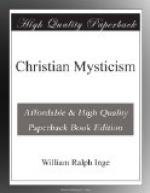is more meritorious than to love our neighbour.[315]”
All this is not of the essence of Mysticism, but belongs
to mediaeval Catholicism. It was probably a necessary
stage through which Christianity, and Mysticism with
it, had to pass. The vain quest of an abstract
spirituality at any rate liberated the religious life
from many base associations; the “negative road”
is after all the holy path of self-sacrifice; and the
maltreatment of the body, which began among the hermits
of the Thebaid, was largely based on an instinctive
recoil against the poison of sensuality, which had
helped to destroy the old civilisation. But the
resuscitation of mediaeval Mysticism after the Renaissance
was an anachronism; and except in the fighting days
of the sixteenth century, it was not likely to appeal
to the manliest or most intelligent spirits.
The world-ruling papal polity, with its incomparable
army of officials, bound to poverty and celibacy,
and therefore invulnerable, was a
reductio ad absurdum
of its world-renouncing doctrines, which Europe was
not likely to forget. Introspective Mysticism
had done its work—a work of great service
to the human race. It had explored all the recesses
of the lonely heart, and had wrestled with the angel
of God through the terrors of the spiritual night
even till the morning. “Tell me now Thy
name” ... “I will not let Thee go
until Thou bless me.” These had been the
two demands of the contemplative mystic—the
only rewards which his soul craved in return for the
sacrifice of every earthly delight. The reward
was worth the sacrifice; but “God reveals Himself
in many ways,” and the spiritual Christianity
of the modern epoch is called rather to the consecration
of art, science, and social life than to lonely contemplation.
In my last two Lectures I hope to show how an important
school of mystics, chiefly between the Renaissance
and our own day, have turned to the religious study
of nature, and have found there the same illumination
which the mediaeval ascetics drew from the deep wells
of their inner consciousness.
FOOTNOTES:
[Footnote 284: Rousselot, Les Mystiques Espagnols,
p. 3.]
[Footnote 285: Among the latter must be mentioned
the growth of Scotist Nominalism, on which see a note
on p. 187. Ritschl was the first to point out
how strongly Nominalism influenced the later Mysticism,
by giving it its quietistic character. See Harnack,
History of Dogma (Eng. tr.), vol. vi. p. 107.]
[Footnote 286: Cf. the beginning of the Vida
de Lazarillo de Tormes, corregida y emendada por Juan
de Luna (Paris, 1620). “The ignorance
of the Spaniards is excusable. The Inquisitors
are the cause. They are dreaded, not only by
the people, but by the great lords, to such an extent
that the mere mention of the Inquisition makes every
head tremble like a leaf in the wind.”]
[Footnote 287: Pedro Malon de Chaide: “Las
cosas en Dios son mismo Dios.”]




